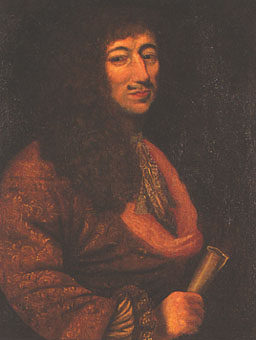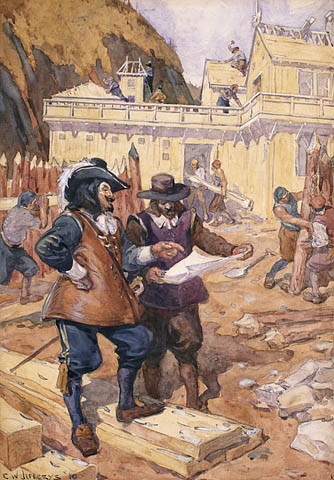The triangular trade was a trade route connecting France, New France and the West Indies. It was established by France’s comptroller general of finance, Jean-Baptiste Colbert, and applied in Canada in 1667 by Jean Talon, the intendant of New France. The triangular trade enabled New France to diversify its economy and establish its position on the international trade networks.
Founding of an Economic System
For much of the 17th century, Canada could not produce enough food for its people. The colony depended largely on imports of wheat from France for its sustenance and, as Colbert wrote, “had to import clothes to put on the settlers’ backs and even shoes to put on their feet.” But in 1665, the situation changed with the arrival of intendant Jean Talon and lieutenant general for French America Alexandre de Prouville, Marquis de Tracy.
Explorers such as Jacques Cartier and Samuel de Champlain provided vivid descriptions of Canada’s natural riches, but Jean Talon was the first to attempt to make systematic use of them. From the moment he arrived, the intendant devoted considerable energy to increasing and diversifying the colony’s production, and in particular its production of food. He distributed 60 new fiefs and issued laws forcing their holders to clear their land, build dozens of new houses every year, and plant new crops, such as hops and hemp to supply the brewing, textile and nautical-rope industries. (See also Seigneurial System; Brewing Industry in Canada). Results were not long in coming. In 1667, for the first time in its history, Canada produced more food than it consumed.
The Marquis de Tracy was then in command of all of King Louis XIV’s forces in New France, including the Carignan-Salières Regiment, which was at war with the Haudenosaunee (Iroquois). In July 1667, a peace was negotiated, and the colony began a new period of growth and prosperity. De Tracy had a thorough knowledge of the West Indies, where he had recently led a highly successful military mission. His knowledge of these islands to prove invaluable to Jean Talon.
French comptroller general Colbert wanted to build an economy in New France that would complement those of France’s other colonies around the world. He therefore encouraged Talon to build shipyards, operate mines and log the forests. But most of all, Colbert encouraged Talon to develop fisheries and agriculture (see History of Commercial Fisheries). Colbert left nothing to chance to make the colony of New France both self-sufficient and competitive in international trade.
Promising Beginnings
Jean-Baptiste Colbert organized the triangular trade (formally described as a “circuitous” trading system) between France, its possessions in the West Indies, and New France. The principle was simple: the more ports at which merchant vessels called on their voyages, the more profit they made. France therefore needed to create a circuit on which each port would be able to import goods off of the ships and export goods onto them. Foodstuffs were to become the foundation of Canada’s export trade. With this policy in mind, Louis XIV ordered Talon to encourage New France’s merchants to “exert all possible care and effort to begin trading by sea, which they can do to their great advantage by shipping wood, salted fish, flour, and other foods and products from New France to the French islands of America, from which they can then bring back, on the king’s behalf, the sugar, tobacco and other goods needed for Canada.”
In fall 1667, a ship of the Compagnie des Indes occidentales set sail from Quebec City to the Windward Islands in the West Indies, laden on Jean Talon’s orders with salmon, eel, dried and undried cod, peas, barrels of seal oil, and wooden boards, staves and small ship’s masts manufactured in Canada (see also Sealing; Shipbuilding and Ship Repair). These goods were sold in the West Indies, where the proceeds were used to buy rum, sugar, molasses, tobacco and coffee, bound for France. Once landed in France, these goods were sold, and the profits were invested to load the ships with manufactured products such as textiles, weapons, salt and alcohol bound for Canada. This marked the beginning of the triangular trade. In the ensuing years, Jean Talon worked assiduously to fill the holds of ships sailing from the port of Quebec City to Martinique with beer, fish, and, of course, fur (see Fur Trade in Canada).
End of a Golden Age
Jean Talon was intendant of New France for only two brief periods: 1665 to 1668 and 1670 to 1672. After his departure, the colony had no intendant for three years. Without the efforts of a man capable of carrying out such ambitious plans, the Crown refused to invest in developing the colony. Although the triangular trade continued in New France, it did not have the same success as in past years. In 1739, the colony played a very limited role in the triangular trade: France remained by far its main customer. In that year, 79.9 per cent of all exports from New France went to France, 12.5 per cent to Acadia and Louisbourg and only 7.5 per cent to the West Indies.
But France did continue to actively pursue another form of triangular trade. Jean-Baptiste Colbert was the initiator of the Edict of March 1685 on the Policy regarding the Islands of French America, later known as the Black Code, a legal document comprising 60 principles governing slavery in the West Indies. Gradually, the triangular trade routes between France and the West Indies were reorganized to include Africa and thus maximize profits from the slave trade. Canada was not an essential component of this economic system, but enslaved Africans were in fact brought into the country (see also Black Enslavement in Canada). This lucrative trade continued until 1834, when it was officially abolished throughout the British empire, including Canada (see also Slavery Abolition Act, 1833). The abolition of the trade in enslaved Africans truly marked the end of the triangular trade in Canada, although it persisted elsewhere in the world.

 Share on Facebook
Share on Facebook Share on X
Share on X Share by Email
Share by Email Share on Google Classroom
Share on Google Classroom











_IMO_9785756,_Maasmond_pic.jpg)





